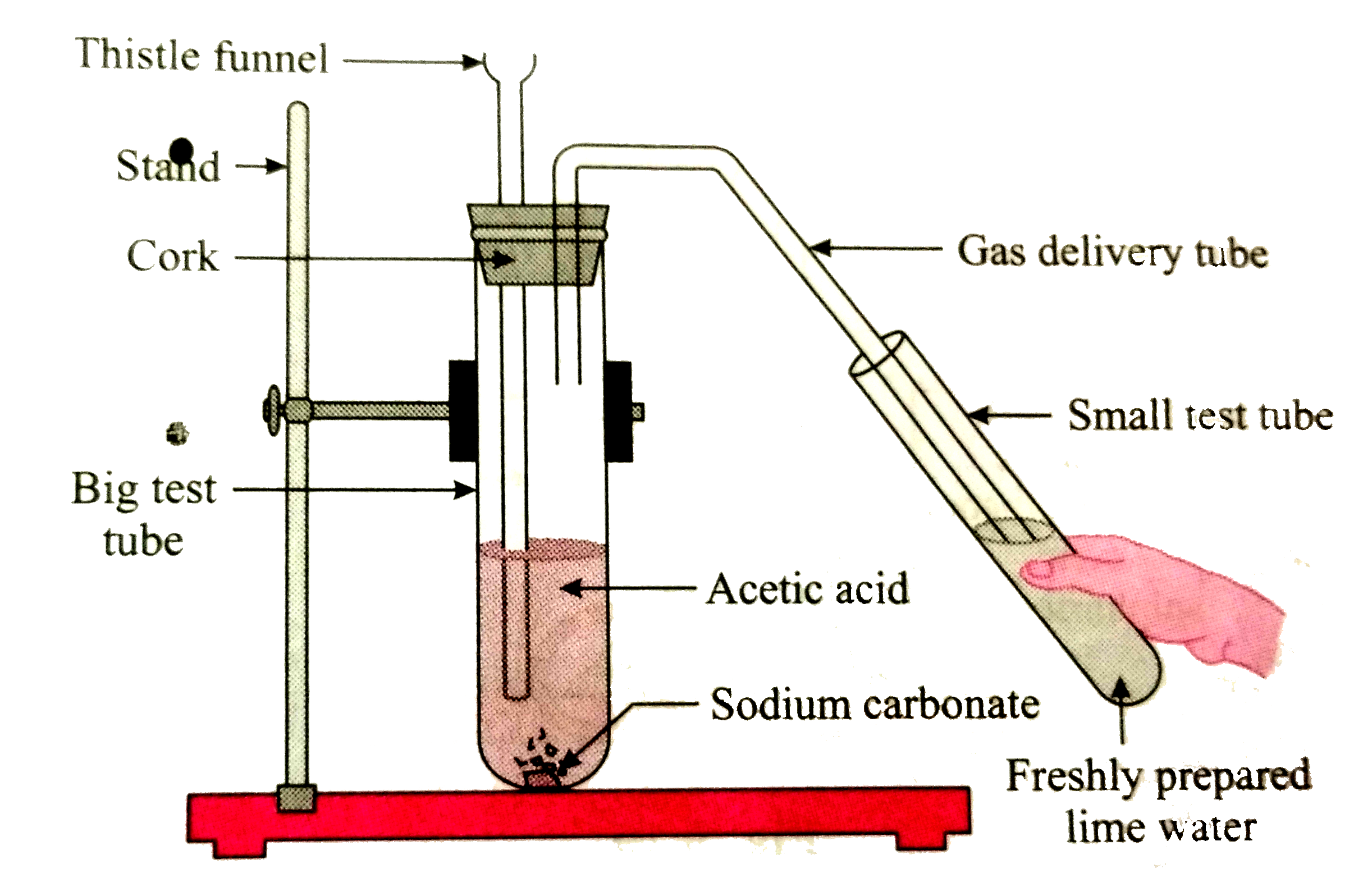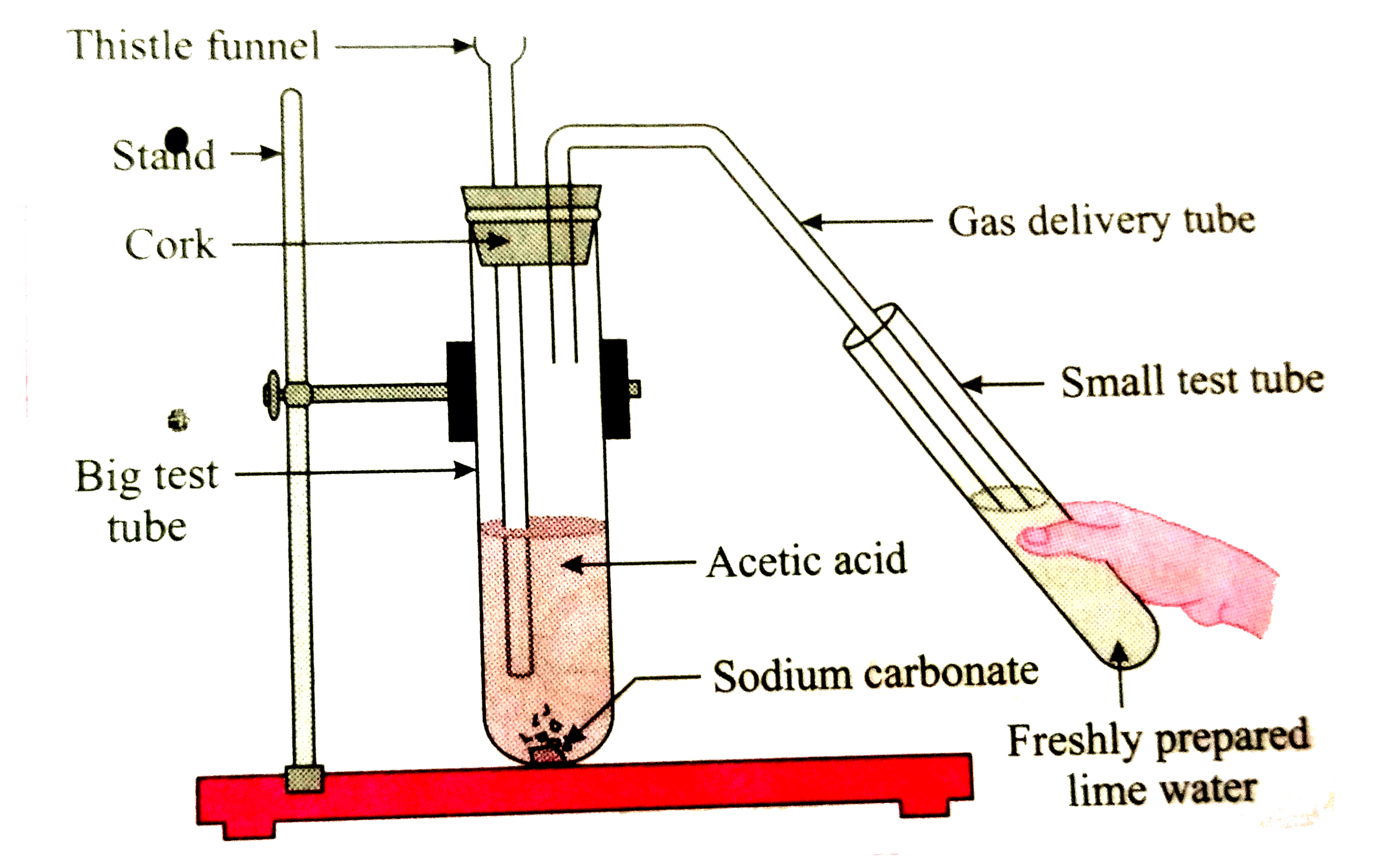Apparatus : Big test tube, small test tube, bent gas delivery tube, rubber cork, thistle funnel, stand, etc.
Chemicals : Acetic acid, sodium carbonate power, freshly prepared lime water.
Procedure : Arrange the apparatus as shown in figure. Place sodium carbonate power in the big test tube. Pour 10 mL acetic acid through the thistle funnel. Observe the changes taking place in the two test tubes.

Why are bubbles seen in the small test tube.
The carbon dioxide gas produced in big test tube passes through bent gas delivery tube to the small test tube containing lime water. Hence, bubbles are seen in the small test tube.
Topper's Solved these Questions
- CARBON COMPOUNDSBOOK - TARGET PUBLICATIONCHAPTER - CARBON COMPOUNDSEXERCISE - Apply your Knowledge(Can you tell)
4 Videos
- CARBON COMPOUNDSBOOK - TARGET PUBLICATIONCHAPTER - CARBON COMPOUNDSEXERCISE - Chapter Assessment (Choose the correct alternative. )
8 Videos
- CARBON COMPOUNDSBOOK - TARGET PUBLICATIONCHAPTER - CARBON COMPOUNDSEXERCISE - Apply your Knowledge(Use your brain power)
36 Videos
- CHEMICAL REACTIONS AND EQUATIONSBOOK - TARGET PUBLICATIONCHAPTER - CHEMICAL REACTIONS AND EQUATIONSEXERCISE - Give balanced chemical equation
26 Videos
Similar Questions
Apparatus: Big test tube, small test tube, bent gas delivery tube, rubber cork, thistle funnel, stand, etc.
Chemical : Acetic acid, sodium carbonate power, freshly prepared lime water.
Procedure : Arrange the apparatus as shown in figure. Plance sodium carbonate powder in the big test tube. Pour 10 ml acetic acid through the thistle funnel. Observe the changes taking place in the two test tubes.

Which gas does come out as effervescence in the big test tube ?
View SolutionApparatus: Big test tube, small test tube, bent gas delivery tube, rubber cork, thistle funnel, stand, etc.
Chemical : Acetic acid, sodium carbonate power, freshly prepared lime water.
Procedure : Arrange the apparatus as shown in figure. Plance sodium carbonate powder in the big test tube. Pour 10 ml acetic acid through the thistle funnel. Observe the changes taking place in the two test tubes.

What is the colour change in the lime water? Write the related equation.
View SolutionApparatus: Two test tubes, bent tube, rubber cork, burner, etc.
Chemicals: Calcium carbonate, freshly prepared lime water.
Name the gas evolved when calcium carbonate is heated.
View SolutionApparatus: Two test tubes, bent tube, rubber cork, burner, etc.
Chemicals: Calcium carbonate, freshly prepared lime water.
Name the solid product left behind on heating calcium carbonate.
View SolutionApparatus: Two test tubes, bent tube, rubber cork, burner, etc.
Chemicals: Calcium carbonate, freshly prepared lime water.
Name the solid product left behind on heating calcium carbonate.
View SolutionApparatus: Two test tubes, bent tube, rubber cork, burner, etc.
Chemicals: Calcium carbonate, freshly prepared lime water.
What are the products formed when evolved gas reacts with freshly prepared lime water?
View SolutionApparatus: Two test tubes, bent tube, rubber cork, burner, etc.
Chemicals: Calcium carbonate, freshly prepared lime water.
What are the products formed when evolved gas reacts with freshly prepared lime water?
View SolutionApparatus: Two test tubes, bent tube, rubber cork, burner, etc.
Chemicals: Calcium carbonate, freshly prepared lime water.
What will you study using above apparatus and chemicals? Draw neat labelled diagram for the experimental setup.
View SolutionApparatus: Two test tubes, bent tube, rubber cork, burner, etc.
Chemicals: Calcium carbonate, freshly prepared lime water.
What will you study using above apparatus and chemicals? Draw neat labelled diagram for the experimental setup.
View SolutionApparatus: Two test tubes, bent tube, rubber cork, burner, etc.
Chemicals: Calcium carbonate, freshly prepared lime water.
Procedure: Take some calcium carbonate in a test tube. Fit a bent tube to this test tube with the help of a rubber cork. Insert the other end of the bent tube in the freshly prepared lime water taken in the other test tube. Heat the powdered calcium carbonate in the first test tube strongly.
What will you observe?
View Solution
